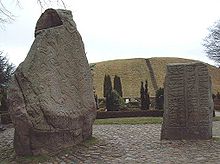Jelling
| Jelling | ||||
|
||||
| Basic data | ||||
|---|---|---|---|---|
| State : |
|
|||
| Region : | Syddanmark | |||
|
Municipality (since 2007) : |
Vejle | |||
| Coordinates : | 55 ° 45 ′ N , 9 ° 25 ′ E | |||
|
Population : (2020) |
3,522 | |||
| Postal code : | 7300 Jelling | |||
| Website: | www.jelling.dk | |||
 Jelling Church (1866) |
||||
The place Jelling [ ˈjɛleŋ ] or Jellinge [ ˈjɛleŋə ] is located in the middle of Jutland , northwest of Vejle . The Royal Jelling is one of the major archaeological sites in Denmark . Between the largest burial mounds (north and south mounds) in Denmark lies a stone church from around 1100 AD, which was built over older wooden churches . In front of it are the Thyrastein and the Haraldstein . The ensemble of church, burial mounds and rune stones was declared a World Heritage Site by UNESCO in 1994 . The square has had cultic significance since the Bronze Age . Not far from Viborg is Mammen, where a splendid ax inlaid with silver wire was found. But it was kings of the 10th century who gave Jelling its current importance.
history
Gorm the old man
The pagan king Gorm the Old is (perhaps wrongly) considered to be the unified kingdom of Denmark. Older, mythologically transmitted kings were probably regional rulers. Gorm expanded the north hill and set the Thyra stone for his wife. A divided wooden chamber was found in the north hill, which is considered a double grave. But it was empty except for a silver cup. Gorm died around 936 (according to other sources 958) AD. The grave was cleared a little later. Whether he or his grandson built the south hill, which was never used, is open.
Harald Blue Tooth
Gorm's son, Harald Blauzahn , did not become king until the age of about 40 and was baptized in 960. Afterwards he probably commissioned the huge rune stone called Haraldstein or the font of Denmark . He had the first wooden church built, in which he transferred his parents. His main residence was probably also in Jelling.
Sven Gabelbart
Sven Gabelbart , apparently born in 965 as the son of Christian parents, was the third son of Harald Blauzahn and the leader of a pagan backlash. In the power struggle between father and son, the king was defeated. During a sea battle, apparently near Bornholm , Harald Blauzahn was wounded and was able to flee on the Pomeranian coast. Harald Blauzahn died there after Adam von Bremen's chronicle, written in 1074, either on November 1st, 985 or 986 in Jomsburg . The royal body was transferred to Denmark and buried there. His son Sven, the subsequent Danish king, is the builder of the Viking castles in the country. This ends the importance of the place Jelling, as the farm was moved to Roskilde , where Harald and Sven are also buried.
See also
image
literature
- Lutz Mohr : The “Little” and the “Big Jellingstein” in Jelling / Jutland / Königraich Denmark - symbol of the fame and power of the kings Gorm the Old (around 900 – around 945) and Harald Blauzahn (around 945–986) during the Viking Age . In: Stone Cross Research (SKF). Studies on German and international land monument research. Edited by Rainer H. Schmeissner, series of monographs, Volume No. 10: Contributions to rune stone research . Regensburg 1999, pp. 64-77
Web links
- Web presence within the Vejle municipality pages (Danish)
- Entry on the UNESCO World Heritage Center website ( English and French ).
- Jelling Project National Museum of Denmark
Individual evidence
- ↑ Statistics banks -> Befolkning og valg -> BY1: Folketal January 1st efter byområde, alder og køn (Danish)
- ↑ Harald Blauzahn's royal court found
- ^ Adam of Bremen: Hamburg Church History. History of the Archbishops of Hamburg . Translated by JCM Laurent and W. Wattenbach. Edited by Alexander Heine. Series: Historians of the German Antiquity . Phaidon Verlag, Essen / Stuttgart 1986, II / 25, p. 106 f.




